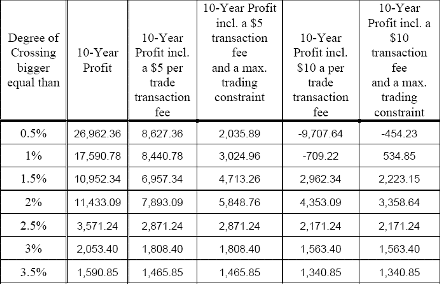In this study, we compared the success rate of method MACDR2 to holding a riskless security, the 10-year Treasury bond, over the 10-year research period. On the start day of this study, the 10-year Treasury yield was 8.268%. Without reinvesting the coupons, after 10 years, $1,000 would have increased to 1,000 x [1+(0.08268 x 10)] = $1,826.80 The benchmark of holding the underlying asset, the NASDAQ-100 index, results in an average yearly increase of 45.62% over the 10-year study period, since the Nasdaq was at 444.21 points at the beginning and 2470.52 points at the end of the 10-year study period.
In dollar terms, $1,000 invested at the beginning of the study would have increased to 1,000 x [1+(0.4562 x 10)] = $5,562.00 excluding reinvestment of the any profit. Holding the NASDAQ-100 can be conveniently achieved by holding the NASDAQ-100 Index Tracking Stock, Symbol QQQ.
The QQQ has a zero dividend yield; therefore, dividends can be neglected in calculating the QQQ increase. Using daily closing prices, the average profits and losses of method MACDR2 were largely symmetrical. An exact 3% gain or loss of every trade can be achieved by intra-day trading.
This requires high liquidity, which is given, since the QQQ trades on a $1/64, thus a $0.01656 minimum bid-offer spread. This minimum spread will soon even narrow to $0.01 with the use of decimals. Table 3 summarizes the MACDR2 performance:

Table 3: Performance of Method MACDR2 including transaction costs and maximum trading constraints
A $10 per trade fee naturally worsens the MACDR2 performance (column 5) further. Together with the maximum trading constraint (column 6), none of the methods outperform the NASDAQ-100 and only 3 out of 7 outperform the Treasury bond. It can be expected that the trading costs will decrease further in the future. Some brokerage houses provide a yearly trading fee with unlimited trading. However, there is usually a maximum dollar trading balance.
At the time of the study (Fall 2000), Merrill Lynch charged a $1,500 yearly trading fee for unlimited trading. However, if the trading balance increases to over $150,000, the yearly trading fee increases to 1% of the trading balance. Naturally the decrease of trading costs will increase the relative performance of method MACDR2. The underlying dollar amount invested at the beginning of the simulation, which is summarized in table 3, is $1,000.
Higher dollar amounts principally increase the relative performance of method 2, since the percentage trading fee decreases. Notably though, the performance including a $5 trading fee and the maximum trading constraint increases only slightly. A starting amount of $10,000 leads to a better performance than holding the NASDAQ-100 for the 1.5% and 2% version (with $1,000 only the 2% version was superior).
The same result is achieved for higher starting amounts than $10,000, both for the trading fee of $5 and $10. One drawback of method MACDR2 is that an investor can be unlucky in the sense that his first trades lead to losses. He can then not reinvest the initial investment amount, as it is assumed in this study.
Gunter Meissner, Albin Alex and Kai Nolte
Next: Conclusion
Summary: Index